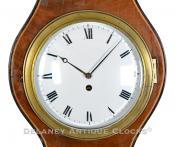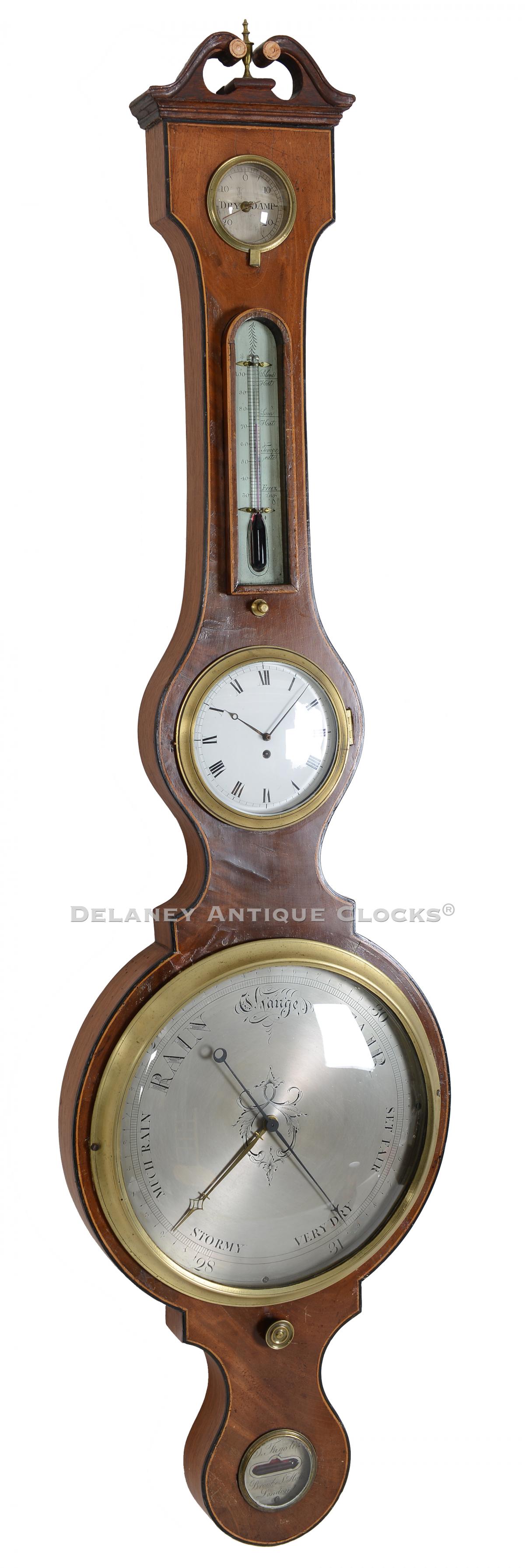D. Fagolil, London Wheel or Banjo Barometer. William Terry, London (Clockmaker) Brooke St. Holborn, London. 223318.
This is an exceptional example of a large “Five Glass” Wheel Barometer signed by the barometer maker “D. Fagolil, London.”
Robert Hooke, “curator of Experiments” in the new Royal Society of London, invented the banjo or the wheel barometer in the 1660s. The mercury-filled tube inside the case is bent into a j-shape. It is filled with mercury in such a way that a vacuum or siphon is formed at the top of the sealed end. A float is positioned in the open end. It is connected to the circular wheel by a counter-weighted thread. The wheel is directly connected to a hand on the viewing side of the instrument. It is positioned in front of a large circular scale or dial. As the float moves with the changes in the mercury level, the hand on the other side turns on the dial. The changes in level result from the changes in atmospheric pressure and thus forecast the coming weather. This wheel format can be easily read from across the room due to its size. Most wheel barometers have a dial that measures more than 8 inches in diameter. Barometers like this became very popular in London beginning in the 1840s and were popular into the 19th century. They are highly valued for their intricate case design, craftsmanship, and functional use. They serve a dual functionality as weather instruments and decorative pieces. They are sought after by decorators, collectors, antique enthusiasts, and those interested in meteorology or vintage scientific instruments. Antique wheel barometers can be displayed in homes, offices, libraries, or other settings, serving as functional tools for measuring atmospheric pressure and stunning examples of craftsmanship from the past.
This is a special example. The case is mahogany and trimmed with a satinwood line and ebony inlay. This decorative detail follows along the perimeter of the fancy-formed case. The current finish is older and has wonderfully mellowed over time. An applied swan’s neck pediment is mounted to the top of the case. The molded arches terminate in bone rosettes. These center an urn-shaped brass finial. Below this is the applied hygrometer.
The hygrometer is held in place with a brass clip and is designed to be removable. One can take this to another location without moving the entire instrument. The hygrometer reads against a 0 – 25 scale. It reads “DRY – Damp.” Below this is a dome-shaped box that houses a thermometer.
This alcohol (red) thermometer is set against an engraved and graduated Fahrenheit scale. “Blood / Heat, Sumr / Heat, Tempe / rate, and Freez / ing” are markers on the thermometer, along with their numerical values that range from 106 degrees to a low of 24 degrees. The thermometer is protected with a glass panel. This entire unit is also designed to be removable or portable and is locked in place with a brass tab.
The clock dial is porcelain and is a slightly convex shape. Roman-style numerals mark the hours on a closed minute ring. This clock/watch is wound with a key through this dial. The glass-fitted brass bezel is hinged and opens to access the dial and the two steel hands. The clock is in excellent condition. It is wound with a key through the dial. The movement is signed on the back plate, “William Terry / London. No. 407.” Terry is listed as a clock and watchmaker in Masham, just outside London, and lived from 1770 until 1840. This fusee clock is designed to run for eight days and retains its original chain. It is of excellent quality.
The main dial is brass and has been silvered. The scale and decorations have been engraved into the front surface. These are relatively standard for this type of instrument. Two hands are necessary. The larger hand is connected to a brass wheel behind the dial. A silk cord is attached to a float, and a counterbalance is inside the case. This cord wraps around a wheel that is attached to the hand. As the level of mercury in the tube changes, a float indicates this motion through this system on the front dial. The smaller brass hand is a marker and adjusts so that one can mark the position of the other hand each time the instrument is viewed. This is actuated with the brass knob located below the center dial. The dial is viewed through a convex piece of glass framed with a large brass bezel.
At the bottom is a spirit level. It is here that the Maker signs the instrument. The signature reads, “D. Fagolil, London. / Brooke St. Holborn, / London”
All of the scales are finished in a silver wash.
This instrument measures approximately 45 inches long and 12 inches wide.
Dominic Fagioli is recorded in Banfield as working in London from 1834 to 1840 and then with his son from 1840 to 1854. They are described as prolific makers.
Inventory number 223318.














